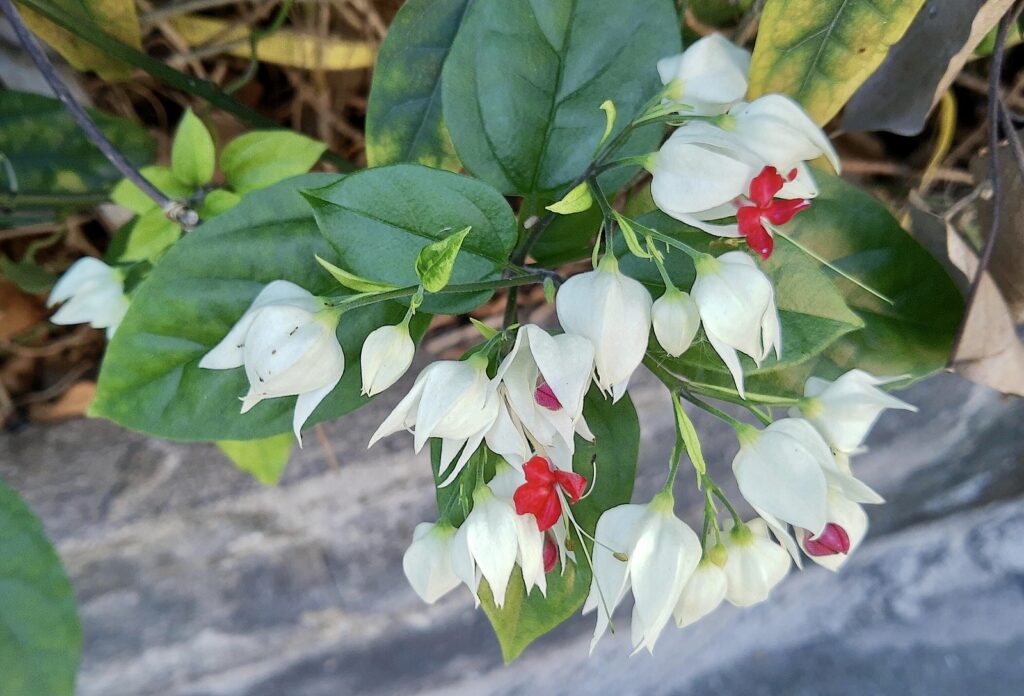Clerodendrum–commonly called bleeding-heart vine–is a tropical vine that features brilliant red and white flowers. As a houseplant, it can be trained to a trellis or it can spill from a hanging basket. If the growing tips are nipped back, the bleeding heart vine can be trained as a small shrub.
Clerodendrum can be trained on a trellis, pergola, or other support in tropical regions. It grows best in full sun but is best shaded from the midday sun in hot regions. Indoors Clerodenrum wants a warm room and humidity.
Clerodendrum is a genus of about 400 species of deciduous and evergreen trees, shrubs, and climbers. Clerodendrum is native to tropical and subtropical regions of Africa and Asia.
Get to know Clerodendrum
- Plant type: Tropical vine
- Growing Zones and range: Zone 10-15
- Hardiness: Tender
- Height and width: Vine grows to 6 feet (1.8m) or more
- Foliage: Dark green, heart-shaped leaves are papery, about 5-inches long
- Flowers: 1-inch tubular flowers, surrounded by large ¾ inch-long white calyxes, borne in flattish 5-inch clusters; flowers can be white, yellow, red, blue, or violet
- Bloom time: Late summer to mid-autumn
- Uses: Border or wall climber in tropical regions; houseplant
- Common name: Bleeding heart vine
- Botanical name: Clerodendrum
- Family: Verbenaceae
- Origin: West Africa

Where to plant Clerodendrum
- Light outdoors: Plant Celerodendrum in full sun.
- Light indoors: Clerodendrum needs bright light, some humidity, and warm temperatures.
- Soil outdoors: Plant in fertile, humus-rich, moist but well-drained soil.
- Soil indoors: Grow Clerodendrum in standard potting soil.
How to water and feed Clerodendrum
- Keep the soil evenly moist when the plant is growing and flowering; it can dry slightly at other times.
- Fertilize with a complete fertilizer during the spring and summer growing periods.
- Feed Clerodendrum growing indoors with a balanced liquid fertilizer monthly.
Clerodendrum care
- To ensure flowering, give Clerodendrum bright but filtered light during the growing season—spring through summer. Keep the soil moist but not wet, created extra humidity by frequent misting or by placing pots on humidity trays.
- In winter give plants rest in a very cool spot, 50° to 55°F (10°-13°C); let the soil dry almost completely between waterings.
- Clerodendrum is fast-growing; it can become rangy if not pruned or pinched regularly. Cutting back by half is not unusual. Pruning encourages future blooms. Prune after flowering usually in late autumn, just before the rest period.
- After the winter rest period, move the plant to a warmer bright spot when new growth appears.
- Pinch off growing tips to keep plants small and compact.
Growing Clerodendrum as a houseplant
- Grow Clerodendrum indoors where room temperature and humidity are high and light is bright.
- Grow Clerodendrum in an all-purpose potting medium that is kept evenly moist when the plant is growing and flowering; allow the medium to dry between waterings at other times.
- Fertilize Clerodendrum every two weeks during spring and summer.
- After plants have bloomed, cut them back to encourage new growth and flowering.
Clerodendrum pests and diseases
- Mealybugs, scale insects, and red spider mites occasionally attack Clerodendrum.
- Clerodendrum can suffer from leaf spots.
Clerodendrum propagation
- Propagate Clerodendrum with suckers taken from the base of shrubs; remove suckers in autumn or spring.
- Root semi-ripe cuttings with bottom heat in summer.
Clerodendrum varieties to grow
- Clerodendum paniculatum, pagoda flower. Shrubs grow 4 feet tall and 3 feet wide; bear scarlet flowers.
- C. thomsoniae, bleeding glory vine. Vining plant grows to 12 feet tall; can be clipped smaller; best adapted to indoor conditions; oval, quilted, shiny, papery, dark green leaves; flowers are red with white calyces; bloom in spring and summer.
- C. trichotomum. Bushy deciduous shrub; grows to 15 feet tall and wide; bears fragrant white flowers.
Clerodendrum frequently asked questions
Q: Can I grow Clerodendrum as a house plant?
A: Clerodendrum is usually grown as a greenhouse plant because its stems can grow to 8 feet long. However, by pruning in winter, it can be trained as a bush or hanging basket plant. Pinch out the tips of weak stems to control growth.
Q: How do I grow Clerodendrum as a house plant?
A: Clerodendrum wants a brightly lit spot away from direct sunlight. It wants to be warm in spring and summer and cool in winter, 55° to 60°F in winter. Keep the potting medium moist at all times throughout spring and summer, then water very sparingly in winter. Fertilize every two weeks during spring and summer.
Q: How do I treat Clerodendrum in winter?
A: In winter Clerodendrum must be given rest with infrequent watering and cool conditions. about 55° to 60°F.
Q: When do I prune Clerodendrum?
A: Cut Clerodendrum back after the plant has bloomed. Pinch off growing tips to keep the plant small and compact. Use the prunings to root new plants.



